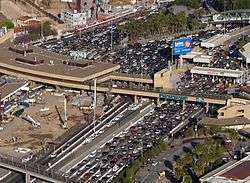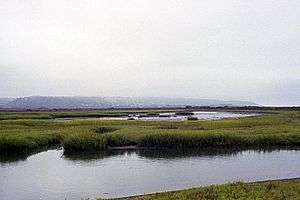Border Field State Park
Border Field State Park is a state park of California, United States, containing beach and coastal habitat on the Mexico–United States border. The park is within the city limits of Imperial Beach in San Diego County, next to the suburb of Playas de Tijuana in Mexico. It contains the southernmost point in the state of California.[2] The refuge forms the southern part of the Tijuana River National Estuarine Research Reserve.
| Border Field State Park | |
|---|---|
.jpg) Border Field State Park sign | |
  | |
| Location | San Diego County, California, United States |
| Nearest city | Imperial Beach, California |
| Coordinates | 32°32′4″N 117°7′22″W |
| Area | 1,316 acres (5.33 km2) |
| Established | 1972 |
| Visitors | 62,000[1] (in FY 2014/2015) |
| Governing body | California Department of Parks and Recreation |
Border Field State Park contains International Friendship Park, which is just inland from the place where the border meets the ocean. Immediately adjacent is the monument marking the Initial Point of Boundary Between U.S. and Mexico.
History
The Treaty of Guadalupe Hidalgo was concluded on February 2, 1848, officially ending the war between the United States and Mexico. It provided that the new international border between the two countries be established by a joint United States and Mexican Boundary Survey. The commission began its survey at Border Field.[2]
- Evolving border barrier at Border Field State Park
.jpg) 1974 border
1974 border 2008 border. (Border Patrol vehicles present in image)
2008 border. (Border Patrol vehicles present in image).jpg) 2014 border
2014 border
Habitat
The Tijuana River National Estuarine Research Reserve contains much of Border Field State Park and is an important wildlife habitat. The salt and freshwater marshes give refuge to migrating waterfowl and resident wading birds, such as black-necked stilt, American avocet, green-winged teal, American wigeon and pelicans. The park offers hiking, horse trails, surf fishing and birding.[2]
Visitors
For fiscal year 2014–2015 61,799 people visited the Border Field State Park,[1] up from 45,633 in FY 2011–2012.[3]
| To the East: San Ysidro |
California State Beaches | To the South Tijuana |
See also
References
- "California State Park System Statistical Report 2014/15 Fiscal Year" (PDF). Statewide Planning Unit Planning Division California State Parks. pp. 32–33. Retrieved June 6, 2016.
- "Border Field SP". California State Parks. Retrieved 2011-10-02.
- "California State Park System Statistical Report 2011/12 Fiscal Year" (PDF). Statewide Planning Unit Planning Division California State Parks. pp. 28–29. Archived from the original (PDF) on June 19, 2014. Retrieved June 18, 2014.
External links
| Wikimedia Commons has media related to Border Field State Park. |
- Border Field State Park
- Border Field State Park (Tijuana River National Estuarine Research Reserve)
- Paul Freeman (8 September 2012). "Abandoned & Little-Known Airfields: California - Southern San Diego area". California Pilot Associated.


